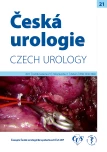RETROPERITONEOSCOPIC KIDNEY TUMOUR RESECTION – VIDEO
Authors:
Milan Hora 1; Viktor Eret 1; Blanka Drápelová 1; Petr Stránský 1; Tomáš Pitra 1; Kristýna Procházková 1; Jiří Ferda 2; Ondřej Hes 3
Authors‘ workplace:
Urologická klinika, LF UK a FN Plzeň
1; Klinika zobrazovacích metod, LF UK a FN Plzeň
2; Šiklův ústav patologie, LF UK a FN Plzeň
3
Published in:
Ces Urol 2017; 21(1): 13-15
Category:
Video
Overview
Introduction:
Minimally invasive laparoscopic resection (LR) of kidney tumours is already a routine part of the spectrum of surgical treatment of kidney tumours, and it is used in a variety of other methods (open resection > laparoscopic nephrectomy > open nephrectomy). At our clinic, we prefer the transperitoneal laparoscopic approach. In exceptional cases (mostly extensive past abdominal surgery in the abdominal cavity), it is necessary to choose a retroperitoneoscopic (R) approach. It should be noted that the LR including RLR are indicated in highly selected cases. In more complicated cases including highly complex tumours open resection is indicated. In this work we present our experience with RLR.
File:
In the period 8/2004–1/2017 we carried out 398 LR. Only in six cases a retroperitoneoscopic approach was used. Five with a medical history of extensive abdominal surgery, one with small tumour located dorsally.
Methodology:
A short incision is guided below the 12th rib; a finger or scissors are permeated to the retroperitoneum. An operation space is formed with index finger or with a dilatation balloon and then after the finger, 3 ports are introduced blindly (2x5 mm and 12 mm) and video port with a fixation balloon is fixed in the initial incision. The kidney is released and tumour is verified sonographically, the renal artery is found and clamped with an intracorporal endo-clamp. Tumour is resected with scissors. A bed of resection is sewn with the V-Loc 90 stitches anchored with non-absorbable Hemo-Lok® clips size M or newly with absorbable PDS clips (Absolok® size AP300), the same technique is used to sew together edges of the resected kidney. The artery is released. Suction Redon drain is introduced.
Results:
No complications specifi c to that approach and no complications in this small highly selected group of patients operated on by the most skilled surgeon occurred.
Conclusion:
Retroperitoneoscopic kidney tumour resection is feasible in routine practice. Continuation self‑anchoring stitch V‑Loc® eliminated the biggest disadvantage of retroperitoneoscopic approach – small operating space knotting sutures. Nevertheless, we still prefer the transperitoneal approach and retroperitoneoscopy is chosen in minimally invasive resections almost exclusively only in imperative cases.
KEY WORDS:
Laparoscopy, retroperitoneoscopy, kidney tumour, resection
Sources
1. Hora M, Klečka J, Ürge T, et al. Laparoskopická resekce tumorů ledvin Ces Urol 2006; 10(1): 32–39.
2. Hora M, Eret V, Ürge T, et al. Results of laparoscopic resection of kidney tumor in everyday clinical practice Cent European J Urol 2009; 62(3): 160–166.
3. Hora M, Eret V, Stránský P, et al. Laparoskopická resekce tumorů ledviny Ces Urol 2015; 19(2): 103–105.
4. Hora M, Eret V, Travnicek I, et al. Surgical treatment of kidney tumors – contemporary trends in clinical practice Cent European J Urol 2016; 69(4): 341–346.
Labels
Paediatric urologist Nephrology UrologyArticle was published in
Czech Urology

2017 Issue 1
Most read in this issue
- Modifications of laparoscopic ureterocystoneostomy
- PEYRONIE´S DISEASE
- THE ROLE OF PSYCHOSOMATICS IN UROLOGY
- RARE CYSTADENOCARCIONOMA OF PROSTATE, CLINICAL APPEARANCE, DIAGNOSTIC PROCEDURES AND TREATMENT
